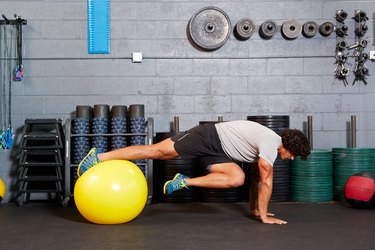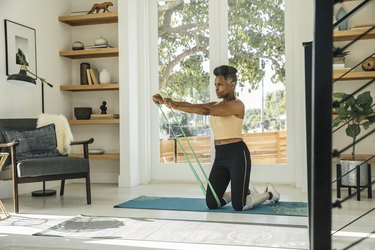

The Pallof press is not like most core exercises. And that's a good thing. Instead of teaching you to crunch, curl or twist, it trains your midsection to resist motion and "hold it right there" for phenomenally strong abs. But it's not like a plank either. It puts zero stress on your wrists or back, you do it standing up and it hits all 360 degrees of your core.
Here's what you need to know about the Pallof, and how to do banded and cable core presses for strong abs, a stable core and a healthier back.
Video of the Day
- What is a Pallof press? It's an anti-rotation core exercise in which you stand next to an anchored resistance band or cable machine and, holding the band with both hands, press the band forward — without letting the band twist or pull you to the side.
- Which muscles does the Pallof press work? It challenges many of the abdominal muscles, including the rectus abdomonis (six-pack muscles), external and internal obliques and erector spinae (muscles that run vertically along the spine). The move also trains your hips to stay in place and resist rotation.
- What is the Pallof press good for? This exercise is great for building a stronger core, more defined abs or a healthier back — no matter your exercise experience or strength level. It's a favorite among novices, elite athletes and physical therapists rehabbing injuries.
Why Is It Called the Pallof Press?
John Pallof, a physical therapist in Massachusetts, is credited with inventing the exercise — so it’s named for him. Sometimes you’ll see articles online spelling it as "Palloff," Paloff," “Palov” or in other ways. Those are just misspellings. It is also sometimes called a cable core press or anti-rotation press.
How to Do the Pallof Press With Perfect Form
- With interlaced fingers or a hand-over-hand grip, grab a resistance band that’s set to chest height.
- Stand with the anchor of the band directly to your left, and step to the left until the band is taut and trying to twist you towards the anchor.
- At this distance, stand with your feet about shoulder-width apart, and bend your knees slightly. Hold the handle in front of your chest. Brace your core.
- Slowly press your arms in front of you until they’re almost completely straight. Pause for a beat, then bring them back to your chest.
- Do all your reps this way, then turn around and repeat with the anchor of the band to your right.
The Best Resistance Bands
- Wsakoue Resistance Bands (Amazon.com, $39.99 for 4)
- TRX Strength Band (DicksSportingGoods.com, $10.99 - 20.99)
- RitFit Resistance Exercise Band With Handles (Amazon.com, $10.95)
Watch the Full Tutorial
Tip
You can do this exercise with a resistance band or cable machine.
With a band, you can use a heavier or lighter band and/or play with the distance between you and the anchor until the resistance feels right.
With a cable machine, add or remove weight to get the right amount of resistance. (Scroll down for a video on how to do the cable Pallof press.)
4 Pallof Press Benefits
1. It Trains Your Core in a Unique Way
Some core moves train your midsection to move — sit-ups, Russian twists, V-ups. Others, like plank variations, train the core to stabilize and avoid bending or flexing. The banded core press is one of very few exercises that trains your core — not just your six-pack, but your entire core, including the rectus abdominis, obliques and hips — to resist rotating.
This is an important skill to keep your torso stable and your body strong enough to hold its own against an external force, both in the gym and in everyday life.
2. It’s Easy to Vary for Skill or Strength Level
If the standing version of the anti-rotation press is too hard, you can simply widen your stance a little. Still too hard? Use less weight or a weaker band. Still not able to resist the rotational pull, or feeling it in your knees? Half-kneeling and kneeling variations (more on those below) make the move easier to focus on your core while keeping your knees out of the picture.
You can also vary the way you do the move: Holding the band still at different parts of the pressing motion can challenge your core in new ways. Instead of immediately drawing your hands back to your chest, try performing 5-second holds while your arms are fully extended.
3. You Can Do It At Home
Even if you can't access a cable stack, you can do the Pallof press at home. If you have a resistance band that can provide enough pull to do the exercise, you can tie the band to a doorknob or the center hinge of a door and get these anti-rotation benefits without needing to go to a gym.
4. It Can Protect Your Lower Back
Fun fact: Our lumbar spines — AKA the lower backs — aren't supposed to twist. This section of the spine is designed to stay relatively stable and resist rotation. If you do force it to rotate it too much, it can be painful and cause an injury. This core move trains your core to stabilize so that your lower spine can effectively resist rotation even when your mid-back (thoracic spine) twists.
This can also help ease existing lower back pain. In a March 2015 research review published in the Journal of Physical Therapy Science, scientists concluded that training core stabilization was more effective for alleviating lower back pain than typical resistance training. The authors noted that focusing on the deeper core muscles — as the exercise does when you're bracing — can be the most effective.
7 Pallof Press Form Tips
1. Tuck Your Tailbone
During this exercise, it's easy to want to pop your butt out behind you and arch your lower back. Resist it. That's your body trying to make things easier on your abs. And while this anterior pelvic tilt position reduces your core benefits, it increases your risk of lower-back strain.
One you get set up to start the move, tuck your tailbone down toward the floor and hold it there by squeezing your abs.
2. Make Sure the Band or Cable Is Taut
In this exercise, the band or cable is trying to pull you towards the anchor, twisting your core. You're trying to resist that twist. If the band or cable isn't pulling you towards the anchor from the starting position, you're not getting the anti-rotation benefits.
Before you start pressing, make sure the cable or band is taut. If it isn't, add weight, adjust your positioning or use a heavier band.
3. Have a Proud Chest
As with almost all exercises, you want your shoulders tucked back and down while performing this press.
To do this, have a "proud chest." You can also think of drawing your shoulder blades together, and then imagine tucking them into the back pockets of a pair of jeans.
4. Go Slow
Don't rip through your reps. Press slowly on each repetition, pause at the full extension point and slowly draw your hands back in.
This will allow you to feel the cable trying to rotate you, and will let you concentrate the anti-rotation force in your core instead of your shoulders, knees or back.
5. Modify If You Feel a Twist in Your Knee
If you're not feeling the challenge of the twist in your core, but instead feel some discomfort in your outside knee, you could be using your knee to resist the rotation instead of your trunk.
In this case, don't do the main move. Instead, try the kneeling or half-kneeling version of the exercise (below) so you can train your core's anti-rotation and avoid straining your knees.
6. Keep Your Hip and Shoulders Steady
During banded core presses, you don't want to hike up your hip or rotate your shoulders. If either of these things are happening, that's a sign your core needs help resisting the rotation — meaning you're using too much weight or too heavy of a band.
Lighten up the resistance so that your core can handle all the work itself.
7. Remember: It’s a Core Exercise, Not an Arms Move
Yes, you use your arms to press the handle away from your chest, but that's to create further instability in your core.
It's the same as if you were holding a dumbbell in front of your chest, or out in front at arm's length — when the weight is farther from your body, your core has to work harder to balance you.
So concentrate on the feeling in your core during the exercise. It probably won't be very difficult for your arms — and that's OK!
The 3 Best Pallof Press Variations
Move 1: Cable Pallof Press
- With interlaced fingers or a hand-over-hand grip, grab a single handle that’s attached to a pulley station that’s set to chest height.
- Stand with the anchor of the cable directly to your left, and step to the left until the cable is taut and trying to twist you towards the anchor.
- At this distance, stand with your feet about shoulder-width apart, and bend your knees slightly. Hold the handle in front of your chest. Brace your core.
- Slowly press your arms in front of you until they’re almost completely straight. Pause for a beat, then bring them back to your chest.
- Do all your reps this way, then turn around and repeat with the anchor of the cable to your right.
Move 2: Kneeling Pallof Press
- With interlaced fingers or a hand-over-hand grip, grab a single handle that’s attached to a pulley station or resistance band that will be at your chest height when you kneel down.
- Kneel on both knees with the anchor of the cable or band directly to your left, and move to the left until the cable is taut and trying to twist you towards the anchor.
- At this distance, set your knees about shoulder-width apart. Hold the handle in front of your chest. Brace your core.
- Slowly press your arms in front of you until they’re almost completely straight. Pause for a beat, then bring them back to your chest.
- Do all your reps this way, then turn around and repeat with the anchor of the cable or band to your right.
Move 3: Half-Kneeling Pallof Press
- With interlaced fingers or a hand-over-hand grip, grab a single handle that’s attached to a pulley station or resistance band that will be at your chest height when you kneel down.
- Kneel on your left knee with the anchor of the cable or band directly to your left, and move to the left until the cable is taut and trying to twist you towards the anchor. In this position, the knee closest to the anchor will be on the floor, and your other foot will be flat on the floor.
- At this distance, set your knees about shoulder-width apart. Hold the handle in front of your chest. Brace your core.
- Slowly press your arms in front of you until they’re almost completely straight. Pause for a beat, then bring them back to your chest.
- Do all your reps this way, then turn around and repeat with the anchor of the cable or band to your right and your right knee on the ground.
Pallof Press Alternatives
While the core press is an excellent anti-rotation exercise, it's not the only one. A few alternatives that also train the core to resist rotation include:
Something these moves all have in common: They require serious core engagement to keep your torso stable and hips square while you do a movement with only one side of the body. That's anti-rotation work right there — and it's a lot more challenging than it looks!
Was this article helpful?
150 Characters Max
0/150
Thank you for sharing!
Thank you for your feedback!


